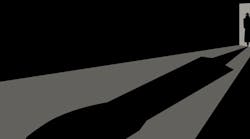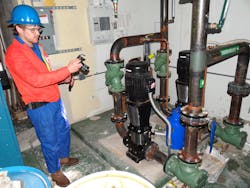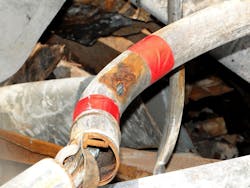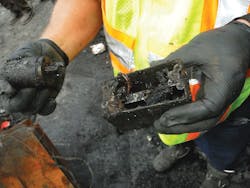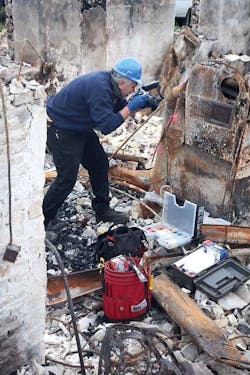Stuff happens. That’s about all that can be (politely) said when systems or equipment fail, people err, or fate intervenes to produce costly mishaps. The fact that accidents of all kinds occur is seemingly the only constant in human affairs. Even in a world where advancing technology, redundant systems, improved training, and a best practices mind-set should produce dividends in the form of fewer “incidents,” a bet on the future looking like the past may be a surer one. Another thing almost certain to stay the same: Loss incidents won’t end with a resigned shrug of the shoulders. Instead, they’ll almost surely continue to signal a beginning, a search for answers to what happened, how it happened, and, of course, who’s to blame.
The quest for the truth in the wake of calamities large and small keeps many interested parties both busy and in business — few more so than forensic engineers who are tasked to help answer those questions. Practitioners who leverage their academic and real-world knowledge of a primary engineering discipline — electrical for one — and combine it with investigatory and analytical skills, have long assisted stakeholders, legal teams, and courts of law in the drive to understand and interpret these incidents. And the work isn’t limited to accidents; many professionals conduct fact-finding in intellectual property cases, contract disputes, and even quality control/troubleshooting in product development efforts. Their painstaking evidence-gathering and generally sworn commitment to unbiased truth-finding is a cornerstone of dispute resolution, permitting a set of stipulated, if not always unassailable, facts to be the basis for fairly determining and allocating culpability, accountability, and damages.
With scant evidence that litigiousness is becoming any less assured than random failures, forensic engineers seemingly can look forward to a continued and steady need for their services. But meanwhile there are also signs that demands on the profession may be changing. From the nature of the electrical-based anomalies that cause damaging events to the emergence of automated controls systems, artificial intelligence, and the Internet of Things (IoT) to the growing sophistication of investigative technologies, the technical terrain forensic engineers must navigate is becoming increasingly complex. In the end, this niche group of electrical experts, who possesses highly specialized, cutting-edge knowledge, and skill sets, is expected to produce bulletproof findings in these cases.
Clues from sensors
High on the list of potential technological challenges that forensic engineers face is the growing ability to monitor, meter, control, and log the operation and performance of electrical equipment and systems. More widespread deployment of digital sensors and smart control systems in commercial and industrial applications could translate to timelier and more clear-cut answers for failures that cascade into accidents. That could prove an invaluable aid to forensic investigators. But could information technology advances also be the seed of the transformation of the traditional forensic electrical investigation?
That’s far-fetched, says Chris Korinek, owner of Synergy Technologies, LLC, a Cedarburg, Wis., forensic electrical, mechanical, and materials engineering and consulting firm. But there’s little doubt, he says, that sensor technology has helped forensic investigators.
“We see more and more appliances collecting data, smart meters monitoring usage, even video of incidents, and it’s all given us more opportunity to collect and use information,” he says.
Data gathered from sensors could well grow to become a major source of hard investigative clues, but it still must be interpreted correctly and properly weighed against other physical evidence, says J. Derald Morgan, principal at J. Derald Morgan & Associates, Inc., an electrical engineering and forensics consultancy in Branson West, Mo.
“It would minimize the need for a certain amount of analysis, and it’s possible you might have some cases where you wouldn’t need a typical forensic investigation,” he says.
But, using an analogy, Morgan says data collected from sensor-equipped cars that collide could yield extensive information about factors like speed, position, and angle of impact. Yet it might reveal little about physical circumstances like the condition of the road surface or weather conditions, which might bear primary responsibility.
For now, says Chris Shiver, who does electrical, mechanical, and safety forensics work as Chris Shiver, PE, out of Roswell, Ga., digital sensor data is just another piece of evidence that “doesn’t short circuit the work you need to do.”
In fact, it may be no more consequential to investigations than data long derived from traditional industrial analog chart recorders.
“It doesn’t prove anything by itself; you still need to find failure mechanisms from all of the physical evidence,” he says.
But the growing prevalence of more sophisticated, data-centric equipment and systems almost surely means forensic investigators will need a strong working knowledge of their operation. That’s a potential challenge for a profession that may be top heavy with seasoned practitioners who, while highly experienced, skilled, and sharp, may be at risk of falling behind a steepening technology curve. Forensic investigations of the future may increasingly demand young professionals well-versed in cutting-edge control and automation technologies integrated into products and systems that may fail with costly consequences.
“This all requires engineers to be a lot more knowledgeable about data, information systems, and electronics,” says Korinek.
For example, prospects for increased litigation stemming from failures of autonomous products and systems in the expanding IoT ecosystem opens the door to forensic experts armed with that specialized knowledge.
On the website of IMS Expert Services, which brings experts and litigators together, there’s this cautionary observation: “All of the things we use to enjoy, control, monitor, organize, and secure our lives via the IoT are coming to the forefront of litigation.”
Morgan, who has more than four decades of experience in electrical engineering forensics study, education, and practice, sees opportunity in the field for those who know their way around complex technologies that will reside at the center of next-generation products and electrical and mechanical systems.
“If I were a young guy and wanted to get good enough at something to become a forensics electrical engineer, I’d get good at artificial intelligence (AI) and computer-based control systems,” he says. “There will be a lot of software controlling things that may fail for strange reasons.”
A youth movement?
That seems like a recipe for growth in the forensic engineering field, one that might be expected to start drawing the attention of newly minted engineers looking for a challenging and possibly lucrative niche. But as established practitioners labor to point out, forensic engineering work has always been specialized and multifaceted, calling on strong communications, investigative, and even performance or “salesmanship” skills — valuable in depositions and trials — that aren’t taught as much as they are absorbed, learned, and honed over time.
Moreover, it’s work that increasingly demands the kind of expertise that qualifies one as a true expert; relevant knowledge must be provable, and investigative processes employed and conclusions reached as a result must be framed to stand up to intense scrutiny. That goes a long way in explaining why the roster of forensic engineers skews older, and why the field has traditionally been more of a transitional career avenue for established professionals rather than a destination for younger engineers.
The best forensics engineers are those who’ve learned the many nuances of the work. A primary one, says Arthur Zatarain, an automation and control systems forensic expert who runs the practice, Arthur Zatarain, P.E., Metairie, La., is blending fact-finding with expert analysis and opinion in a case.
“A forensic engineer can get caught with one foot as a fact witness and the other as an expert,” he says. “That situation is ripe for attack by opposing counsel.”
Forensics engineers who carefully discover and cite facts in reports, and have the ability to present themselves as experts who can opine on them, bring an important dimension to investigations, he says. In his reports, he develops separate sections — one for facts and the other for analysis and opinion on them based on his credentials and experience.
“That method keeps those two worlds — fact and opinion — clear and separate,” he says. “I often see mistakes along those lines in expert reports, which suggests to me the engineer, and perhaps his attorney client, are new to the game.”
Experience is of great value in the profession, but some have detected signs of a youth movement into the practice as demand for services expands, niche expertise is valued, and attrition accelerates.
“The field seemed to start expanding around the turn of the century,” Shiver says. “When I got into the business, there weren’t that many companies doing it — and no one wanted to be a forensic engineer starting out. Now younger engineers seem to be going to work for big companies that are starting to get more established in the business.”
While there are solid opportunities in forensic electrical work, that doesn’t translate to an easier path for those looking to break in. Barriers to entry and sustained success, especially for engineers looking to hang out their own shingle, are high because a track record in all facets of the work is so highly valued and becoming known and trusted can be a long, uphill climb.
Zatarain says “artistic” elements of the work that complement the technical aspects — investigating, analyzing, assembling reports, and testifying — can be difficult to master. Even seasoned engineers enticed by the fresh challenge of adapting their knowledge and skills to the field as sole proprietor consultants need to go in with eyes wide open.
“Going in completely on your own is probably not a good idea,” he says. “If you’ve never done a case before, you can get chewed up the first time, and the process will consume you.”
Fewer trials
However, one element of that process that has traditionally hung over the head of every forensic engineer may be changing somewhat — the need to be ready to testify in a courtroom setting. According to some forensic engineers in certain geographic locations, they’ve noticed a trend toward fewer cases going to trial. Instead, often for financial reasons and the pervasiveness of stalemates, more disputes seem to be settled out of court.
“There are fewer trials,” Morgan says. “They’re expensive, and judges are tending to force parties to mediate disputes.”
Settlements may be more commonplace partly because litigants have become so much more focused in recent years on engaging top-notch experts, as defined by courts, as investigators. Deadlocks often ensue, Zatarain says, because all sides present equally strong cases that can be costly and time-consuming to continue to challenge.
“Ultimately, you often end up with opinions, and that’s where it stops, with the sides negotiating a settlement,” he says.
Depositions remain commonplace and pivotal in the forensic investigation process, requiring forensics engineers to be as capable handling probing and sometimes hostile attorney questioning as they are at gathering and assessing evidence.
“Testimony by deposition is still very much a part of the job,” says Zatarain. “In my experience, a deposition is far more difficult than a trial. They can be vicious, and all facts aren’t always known to the engineer prior. Getting through the depo with the case still intact requires a seasoned forensic engineer.”
And demands on engineers to defend their qualifications, reports, and findings have grown ever since the 1993 “Daubert” Supreme Court case established a tougher standard for admitting expert testimony, says Korinek. It’s had the effect of increasing the diligence of forensic engineers to understand the issues, conduct thorough investigations, and prepare for challenges to conclusions.
“It can be humbling how many things you have to look at to be able to make a case,” he says. “A lot of the engineering work is focused on finding out what happened, but often the big issue in a case comes down to an attorney asking the question: ‘Who did something wrong?’” — who performed an action that caused a loss due to not meeting a standard of care?
Ultimately, the definitive answer to whether someone is negligent or legally liable often lies outside the scope of forensic engineers. That determination, in the legal sense, is for others to decide: judges, juries, and the litigators themselves. It remains the job of forensic investigators to prepare evidence, establish facts, and help chart a path to informed and equitable dispute resolutions. Armed with these facts, not to mention more advanced tools and an intense interest in electrical investigation and analysis, a new generation of electrical engineers will inevitably be poised to take the field into the future.
Zind is a freelance writer based in Lees Summit, Mo. He can be reached at [email protected].
SIDEBAR: The Fascination with Electrical Forensics
There are few jobs like it in the world of electrical engineering. Combining deep academic and practical engineering knowledge, investigative know-how, and comfort with being on the hot seat, forensic electrical engineering is a true occupational hybrid. And that’s exactly what attracts many to the field and keeps some fully engaged in it well into their golden years. Variety, drama, occasional pressure, and, yes, good paydays for the very best, are among the enticements.
“I love it because it calls on both sides of your brain,” says Robert Peruzzi, PhD, owner of R. Peruzzi Consulting, Bethlehem, Pa. “I’d been a technical nerd for a number of years, and now it’s also about being able to communicate in writing and speaking — and being able to withstand hostile examination. You have to be able to build a structure to support your case.”
Arthur Zatarain, a practitioner in Metairie, La., says the variety is part of what keeps him in the business.
“Every case is unique, and there’s nothing routine,” he says. “The technical requirements, human factors, environmental conditions — they’re all different, and you can hardly ever say ‘I had a case just like this.’ And before you can do anything, you have to first figure out exactly what the case is.”
J. Derald Morgan, who’s 78 and runs J. Derald Morgan Associates, Inc., continues to be energized by the educational aspects of the work and the varied skills it calls on in depositions and trials. Some forensic engineers find that part of the work distasteful because it doesn’t come naturally.
“Engineers are actually good writers, but they’re not creative writers,” he says. “They may be able to diagram sentences, but if you do that on the witness stand and come across as hesitant, it can look like you’re making up a story.”
A good forensic engineer, he says, needs to be skilled at the nitty gritty of gathering evidence, but capable of shifting gears into defending the findings. “You need to realize that when you go to trial, it’s showtime.”
Chris Shiver, who runs his own consulting business out of Roswell, Ga., likes the work for the demands it places on scientific rigor and the need for objectivity and pure fact-finding.
“You need to maintain ethical principles even where you might be subject to being pulled in different directions,” he says. “You don’t go in with a lot of pre-conceived ideas, but let the circumstances lead to unbiased conclusions.”
